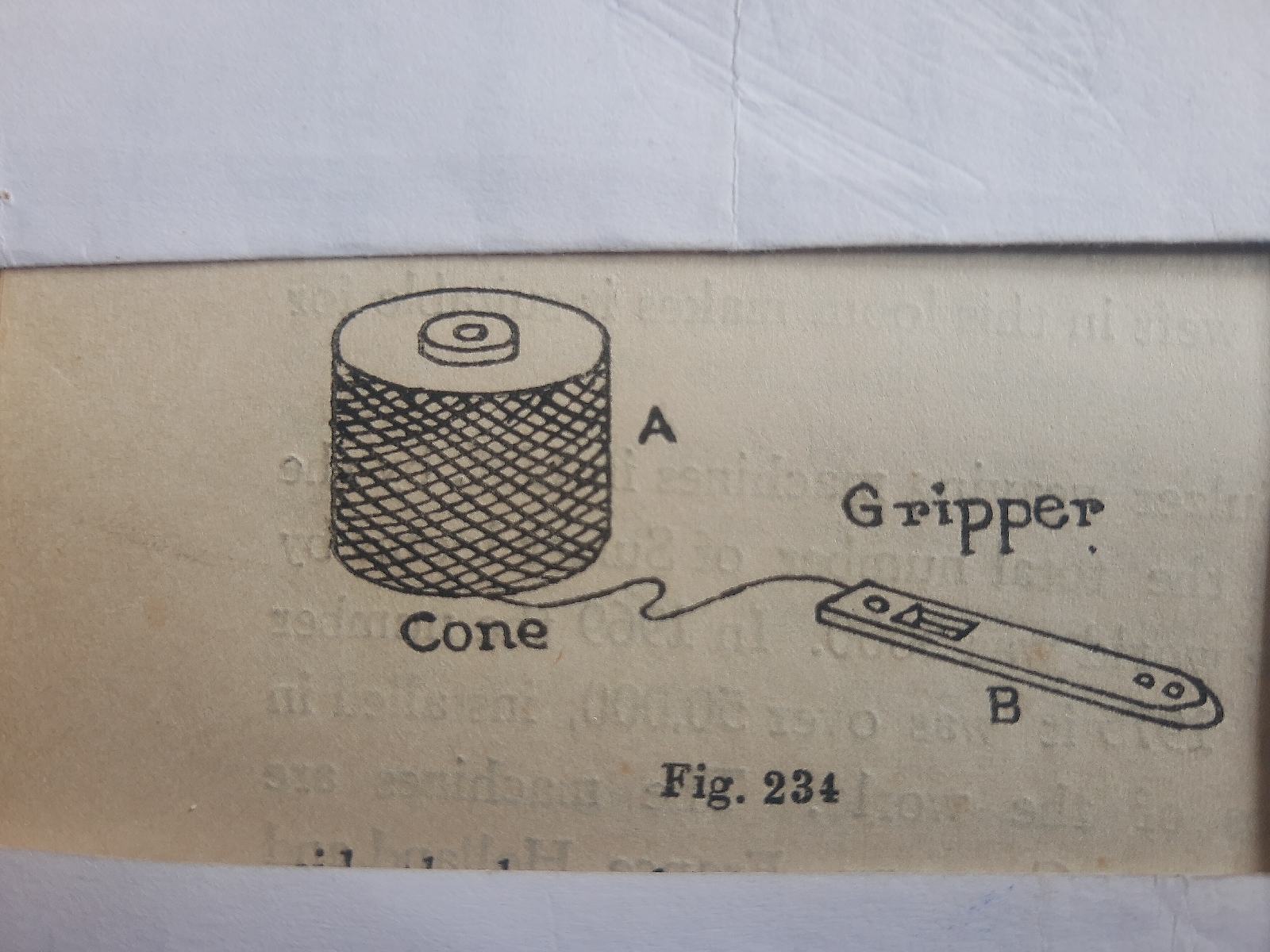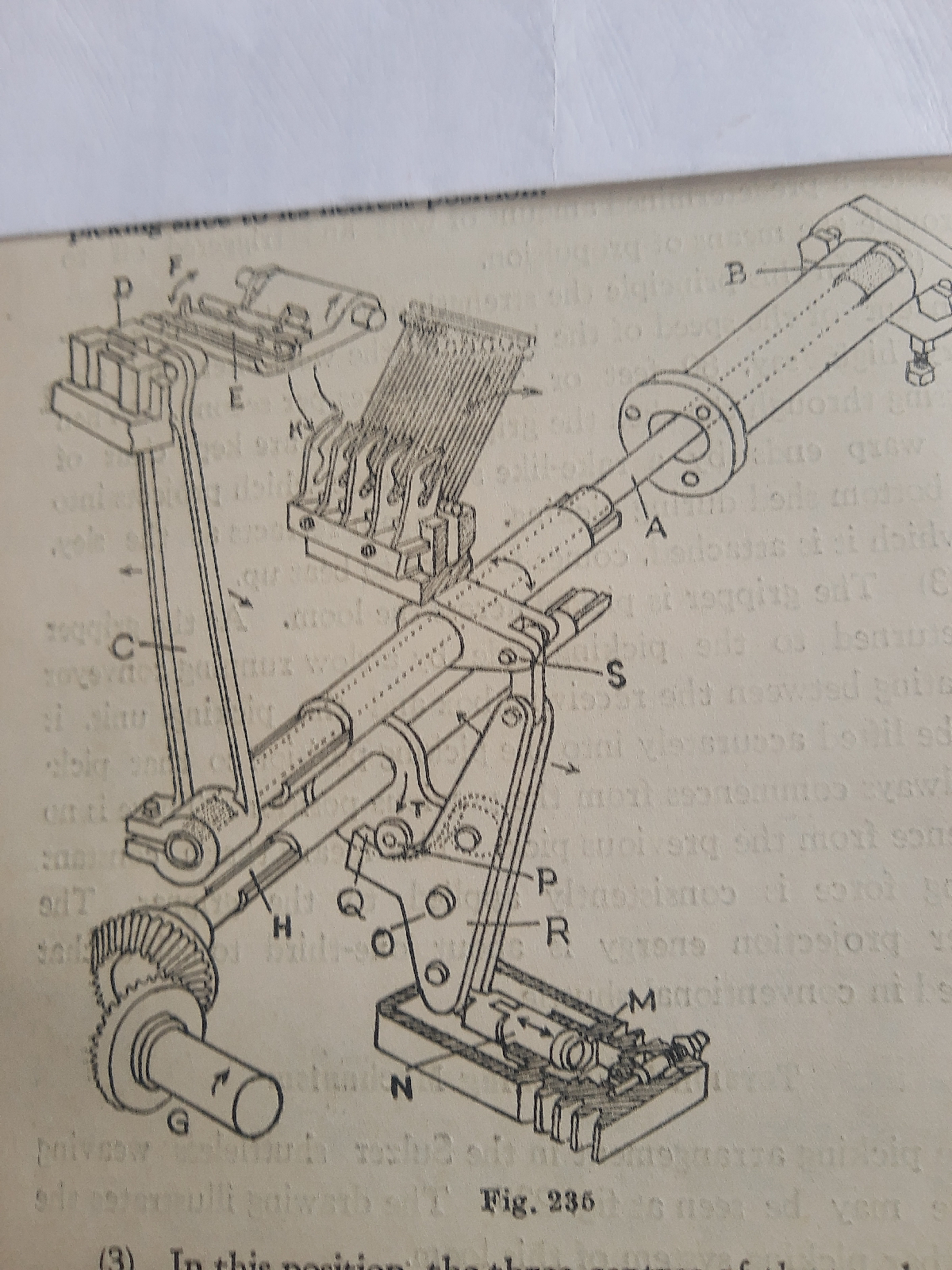Sluzer Shuttleless Weaving Machine:-
Sluzer Shuttleless Weaving Machine:-
The Sulzer shuttle less weaving machine invented by Sulzer Brothers Ltd. Zif Winterthur, had been at the Basic Fair in 1953 and since then it found a commercial market.
1) The basic principle of Sulzer weaving machine is the introduction of a small metal carrier , a miniature shuttle, about 3.5 inches or 8.89 cm. long and 1.15 to 1.5 oz or about 32 grams to 43.5 grams in weight, with a gripper to hold the weft thread from a cross wound bobbin. The gripper shuttle is without a tongue and has no arrangement for holding the weft. But its gripping finger draw the weft from a large stationary package placed below the loom in a container and pass this weft through the division of warp threads at high speed. After picking the weft is cut near the selvedge and the gripper shuttle is thrown on the conveyor . The reed the comes forward to beat-up the last pick of weft
2) In this loom several gripper shuttle are placed on a a slow speed conveyor and the move in a cyclic way. The number of gripper shuttle used depends upon the width of the loom and the quality of cloth. After effecting a pick , each gripper shuttle returns to the picking side by the conveyor, all the picks being delivered from the same side, and means are provided for attaching the thread to the gripper.
3) The Sulzer models ,85ES 10E to 130 ES 10E with reed spaces of 85" or 215 cm to 130" or 330 cm, have been invented. These models are now supplied with single , two, three or four color weft insertion and also with 18 shaft positive Staubli dobby . The color sequence is controlled by the dobby. The perfect control of the weft in this loom makes it suitable for the woollen industry.
4) The number of Sulzer weaving machine in U.K. by the end of 1962 was 700 and the total number of Sulzer looms by that time installed in the world was 5000 . In 1969 the number rose to 20,000 and in 1975 it was over 50,000 installed in sixty different countries of the world. The machines are generally installed in Western Germany, France , Holland and Belgium.
5) The Sulzer loom can weave a wide range of weft yarns of adequate strength and good unwinding quality , namely, 9" to 60" cotton 6" to 36" spun rayon , continuous filament yarn 68 denier 270 denier 6" to 27" woollen yarn and 21/8" to 25/4" worsted yarn.
Principle of Sulzer Shuttle Weaving.
The basic mechanical principle of the Sulzer shuttleless weaving machine are to be considered under the following four heads :-
(1) Picking, or weft insertion system,
(2) Beating-up ,
(3) Selvedge formation,
(4) Weaving with one, two, three, or four colors.
In the Sulzer weaving machine , the weft yarn is introduced into the cloth by means of a gripper. A tuck in selvedge is formed by drawing the cut end back into the open shed by means of tucking needles . The pick is then beaten-up . The sley is not moved through cranks , but is positively rocked about its center through saddle carrying follower bowls , each bearing against the surface of matched cam.
Weft package and Gripper:-
In the Sulzer loom, the torsion bar picking system is used for the propulsion of the gripper through open shed . The weft package and the gripper are illustrated at fig 234.
GRIPPER:-
The Sulzer shuttleless weaving machine has a gripper B sometimes called a 'miniature shuttle’, 3.5 inches or 8.89 cm. long, 0.55 inch or 1.4 cm. broad and 0.24 inch or 0.6 cm. deep for picking . The picks are made from
only one side of the loom , that is the picking side. The weft package A is placed out side the loom framing on the picking side. All the picks are delivered from the same side. There are means provided for attaching the weft thread from the weft package A to the gripper B. The gripper translate the warp threads in guides disposed midway between the top and bottom lines of shed and therefore, doesnot touch the warp in any way. The gripper is also known as “gripper shuttle"
TORSION BAR PICKING:-
1) Several gripper shuttles are employed for sulzer shuttleless weaving machine. They are returned to the picking side by s conveyor fitted below the sleyrace. The gripper carries the pick of a weft through the shed using energy derived from the shear strain energy stored in a torsion bar, which is twisted a predetermined amount of weft and triggered off to provide the means of propulsion.
2) In this principle the strength of the pick is quite independent of the speed of the loom and the weft insertion is also very high , say 80 feet or 24.38 meters per second. When passing through the shed the gripper shuttle are kept clear of the warp ends by a rake-like steel guide which projects into the bottom shed during picking . It again retracts as the sley to which it is attached, comes forward to beat-up.
3) The gripper is picked across the loom. As the gripper is returned to the picking side by a slow running conveyor operating between the receiving box and the picking unit , it can be lifted accurately into the picking position so that picking always commences from the previous pick. This means that a constant picking force is consistently applied to the gripper. The gripper projection energy is about one-third to half of that required in conventional shuttle.
Torsion bar picking mechanism:-
The picking arrangement in the Sulzer shuttleless weaving machine may be seen at fig. 235. The drawing illustrates the torsion bar picking system of this loom.
1) The torsion bar A has its splined end B rigidly constrained and adjustable plate with provision for adjusting the twisting angle hence, the gripper projection velocity. The other end of the torsion bar is splined into the picking arm C , which carries the picking shoe D at its upper extremity. The gripper E is shown in the shuttle lifter with the gripper spring opener F. The conveyor is not seen in the figure but it is placed under the sleyrace at the back center picking position.
2) The bevel wheel drive G rotates the picking cam shaft H, which carries the picking tappet T. The pivoted lever S is rigidly connected to the torsion bar, and through a short linkage to the toggle plates R, centred at O. The action of the cam is for the small bowl P to bear against the toggle Q rotating is anticlockwise about the centre O, thus withdrawing the the picking shoe to its nearest position.
3) In this position, the three centers of the toggle arrangement are in line , and the torsion bar is twisted to its maximum. The nose of the picking cam then bears against the bowl carried between the toggle plates, and moves the central pivot of the toggle arrangement off the line of centers. Thus permits the whole of the shear strain energy to be transmitted instantaneously to the gripper.
4) The gripper leaves the shoe after about 1.5 inches or 6.35 cm. of travel at 78 feet or 23.78 meters per second after being subjected to a maximum acceleration of 21,760 ft/sec square or 6632 meters/sec square at a point about 0.6 inch or 1.52 cms. from the gripper rest position. The residual energy in the picking system is absorbed by the hydraulic system, about 62.5 percent energy is dissipated in the picking unit brake . The body M and the plunger N are shown in the figure. The gripper guides K are also shown.
5) After the gripper has come to rest under the shuttle brake, it is returned 1.6 inches or 4.06 cmd. to 1.8 inches or 4.57 cms
in fixed position in relation to the receiving side selvedge, prior to being ejected into the receiver and dropped on to the conveyor. The picking track is locked between the picking and receiving units at the back center and the pick is delivered across the stationary sleyrace. The forces acting on the gripper, other than the gravity, are the picking force and the yarn tension, both acting slong its major axis. The guide blades are lubricated with thin oil , picked up from the gripper. As a result , the energy is very slow. The loss is 3.5 percent of the energy applied to the torsion bar.
The effective reed space in a Sulzer shuttleless Loom is higher than the effective reed space obtained in a similar width conventional loom.
Ref:- Weaving Mechanism Book Vol.II by Prof. N. N. Banerjee.




Comments
Post a Comment